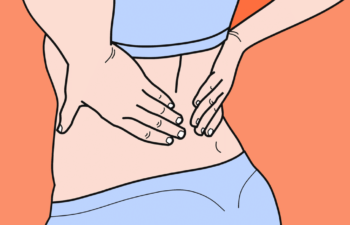Low back pain associated with sciatica is a very common, self-limiting condition. It can significantly reduce the quality of life associated with activities of daily living. In the US alone, more than 6 million people suffer from sciatica each year, costing the healthcare system billions of dollars.
The lifetime prevalence of sciatica and low back pain is approximately 60-75% and affects men and women equally. Sciatica usually affects people in their 4th or 5th decade of life. Surgery to correct sciatica is common among people in their 4th decade of life. See also How to relieve sciatic nerve pain? for more information.
Definitions
Low back pain affects the back between the chest cavity and the bottom. It often radiates into the back of the thighs. Sciatica is back pain affecting the distribution of a lumbar nerve root. It is often associated with abnormal sensory and motor deficits. The pain can be made worse by walking and other movements.
Risk factors
- Family history of Lower back pain associated with sciatica
- Occupations which involves frequent bending forward and backwards
- Occupations involving frequent weight lifting
- Osteoporosis
- Congenital lordosis and scoliosis of the spine
Practical Anatomy
The anatomy of the lumbosacral and sacroiliac regions is very complex. It consists of different bones, ligaments, joints and other soft tissues. Each of these can contribute to sciatic pain, and there can be combinations of different pathological processes for sciatica. There are two main theories about the pathophysiology of sciatica:
- Referred pain theory
- Compression theory
The first is referred pain. Pain can occur in any muscle, joint, bone or other soft tissue and can be referred to the nerve. The second is compression or irritation of the sciatic nerve root by any internal or external factor.
The spinal cord is the extension of the brain stem that runs through the spinal canal of the spine. It runs and gives off branches along its course. The spine is made up of several vertebrae and between each vertebra there is a gap (intervertebral foramen) through which the nerve can exit. There is usually a ganglion, which is made up of nerve fibres and helps the nerve to transmit signals effectively.
The nerve may be larger than the space for various reasons, causing it to be compressed. The intervertebral joint has a capsule that encloses the nerve and the ganglion and if there is any swelling or other inflammation in the joint capsule, it can compress the nerve and cause pain.
There are a few ligaments that bind the vertebrae together, such as the supraspinous, infraspinous and longitudinal ligaments. They surround the vertebra. If the ligaments are diseased, they can pinch and compress the exiting nerves and cause sciatica.
The intervertebral joint consists of two vertebrae and an intervertebral disc. The vertebrae are hard bones and the disc is a soft, jelly-like material that lubricates the surfaces of the hard vertebrae. If there is pressure from above or below the vertebra, the disc tends to herniate. Like a slice of meat between the slices of bread in a sandwich. The herniated disc can press on the nerve. The pressure irritates the nerve and causes it to be stimulated, causing the sciatica pain. In the long term, this pressure can cause physical damage and permanently damage the nerve, resulting in permanent sciatica, which is a very painful condition. This is also known as chronic sciatica.
Chronic diseases
In patients with chronic diseases such as diabetes mellitus, amyloidosis and hypothyroidism, the bony surfaces of the intervertebral joint become thickened. This thickening is caused by the deposition of various substances from the blood. The thickened surfaces put more pressure on the nerves, causing them to become stimulated. These stimulated nerves cause sciatica pain.
Malignant diseases of the bones and other soft tissues, such as ligaments, can also thicken the bony surfaces, compressing the nerves. Classic examples are various connective tissue tumours and bone cancers such as multiple myeloma, osteoma and osteosarcoma.
The intervertebral disc can be affected by cancers of connective tissue origin. The classic examples are costochondromas and costochondrosarcomas.
Bones are prone to degenerative changes known as osteoporosis. These degenerative changes typically affect the spine because the spine is like a skyscraper made up of many floors. The floors are like the vertebrae. When a vertebra is affected by osteoporosis, it can collapse, causing the vertebral body to disintegrate. Adjacent vertebrae may be affected. This compresses the nerve that exits between the two vertebrae, causing sciatica.
Osteoporosis is one of the most common mechanisms of sciatica in the very old population, but can also be a cause of sciatica in patients with nutritional deficiencies such as calcium and vitamin D. There can be congenital errors of vitamin D deficiency which can cause osteoporosis and in turn cause sciatica.
Trauma
Spinal trauma is a common scenario in RTA. Due to advances in modern medicine, healing of injuries is a common scenario. When bones are broken, healing can be disorganised. The same is true for vertebrae. As the vertebral fractures heal, they can compress the nerves and cause sciatica.
Summary
Lower back pain associated with sciatica is a common condition for many people. Many factors contribute to the development of sciatica and lower back pain. Modern medicine has developed a number of treatment strategies for sciatica.







